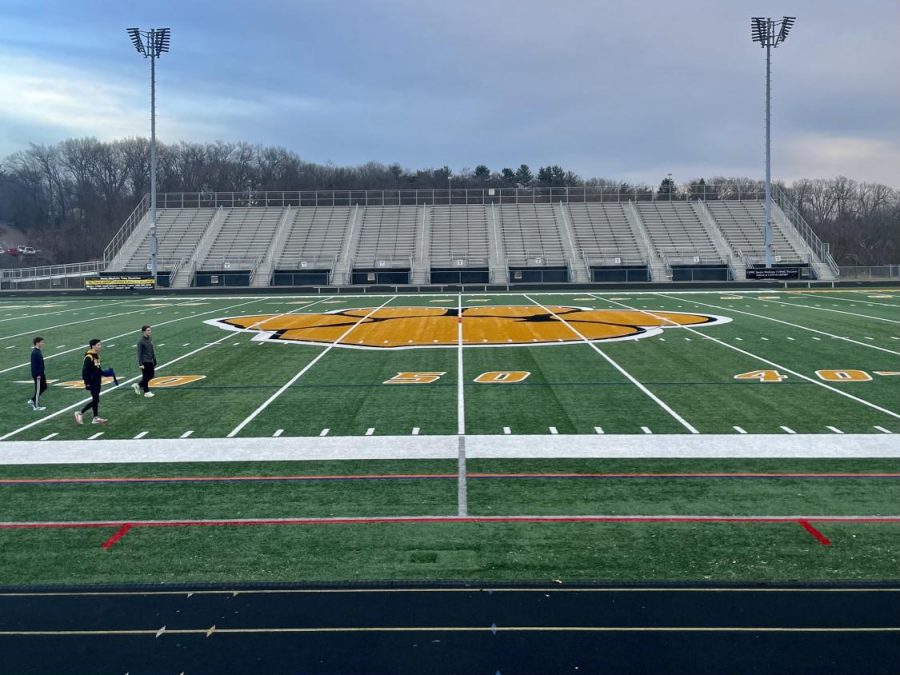Reaching New Heights
With better training and technology, today’s athletes are breaking new ground, starting in high school.
NA’s Newman Stadium has been around for nearly five decades and has seen athletic records broken over and over again.
January 24, 2023
Professional athletes have been breaking records and reaching new heights left and right with the help of technological advancements and general knowledge. As these advancements make their way into high schools around the country, the trend of record breaking athletic performances looks primed to continue.
The answers lie within the coaches who have been there since the beginning. Daniel Schall, NA’s varsity boys volleyball coach, Andrew Heck, NA’s varsity baseball coach, and John Neff, NA’s head track & field and cross country coach have experienced and seen the step up in high school athletics.
“Yes, the level of play has continually risen in the sport for both girls and boys,” says Schall. “The new normal keeps getting stronger, taller, and more skilled,” he adds.
“Players and coaches are beginning to understand this so you are seeing more and more young players working to become good athletes at a younger age,” Heck says.
Athletes are clearly becoming more aware of what they need to do to reach their full potential. Whether it has to do with observing gameplay or analyzing stats, most people are able to see a difference from the past to the present.
Watching players perform is a good way of evaluating skill level, but other objective measures clearly depict the comparison of skill level of athletes over years.
The most accurate way to track progress is to look at numeric values like times, heights, and distance. Track and field is one of the sports where skill is easily reflected in the statistics. The sport has been around NA since the mid 1900’s.
“I think students are getting better on average, especially when you look at the shorter events,” says Neff.
This is because a small change in an event like the 100m dash can put someone in a whole new level, while if someone were to better their mile time by a given amount, it might only slightly improve the performance.
During the 2022 track season alone, four school records were broken.
By looking at these three sports, we can tell that there is a positive trend in the skill levels of high school athletes. Now the greater question is, what allows them to break barriers and reach their full potential?
“I think knowledge and awareness have been major factors. Social learning—learning through watching and imitating others—is critical in skill sports,” says Schall.
Watching television and analyzing professional athletes is a great way of learning how other people find success in their sport. It sets new standards and shows younger athletes what is possible if they work toward their goals.
From a mindset standpoint, athletes need to be able to handle the stress of working through the good and bad times.
“At the high school level, I think the two most valuable factors for getting players to play to their full potential is knowledge of the game and mental toughness,” says Heck.
Heck goes on to say that the mental side of baseball is the main reason why many players do not reach their full potential.
As well as mental toughness, there are technological advances that assist in improving athletes.
In baseball, volleyball, and running, video analysis, statistics, and algorithms give coaches the ability to enhance the level of play. Looking at data from past performances can help a player to know what specifically they can improve upon.
“From heart rate monitors, GPS watches, and even sophisticated wearable sensors can tell give feedback on how taxed the body is becoming, when the body needs more rest vs is ready for stress, and when an overall training volume can be increased,” says Neff.
Utilizing not only data but also equipment is key in becoming a stronger athlete.
“One thing that has really changed over the past 10 years is the number of opportunities for young players to work on baseball during the winter months at indoor facilities that have popped up everywhere,” says Heck.
Specifically, in northern climates, indoor turf fields, weight rooms, and tracks can keep players from having to focus less on what the weather is like and more on improving at the game.
As coaches, it is their responsibility to guide athletes toward their full potential. Scientifically, they are coming up with better ways of determining an athlete’s physical and mental stress. From there, they can decide what changes they want to make to their training plan.
“In both cases, too little recovery time will lead to injury and inconsistency of training; too much recovery time will lead to a runner not achieving the potential gains from the training,” says Neff.
Some components that can help with recovery are sleep, nutrition, hydration, stress management, and mental skills. Neff also mentions that nutrition and fueling the body are key.
The future is extremely bright for high school athletics, and players will continue to become better by utilizing their resources and learning more about the small details that allow them to make advances.
“I expect the game to continue to develop—to get more powerful and faster. As athletes get bigger and jump higher, I would not be surprised to see the court expand or the net to be raised in decades to come,” says Schall.













Whitney Patton • Feb 12, 2023 at 5:50 pm
Great article Jack!!
Joseph Li • Jan 26, 2023 at 1:40 pm
i love you jack